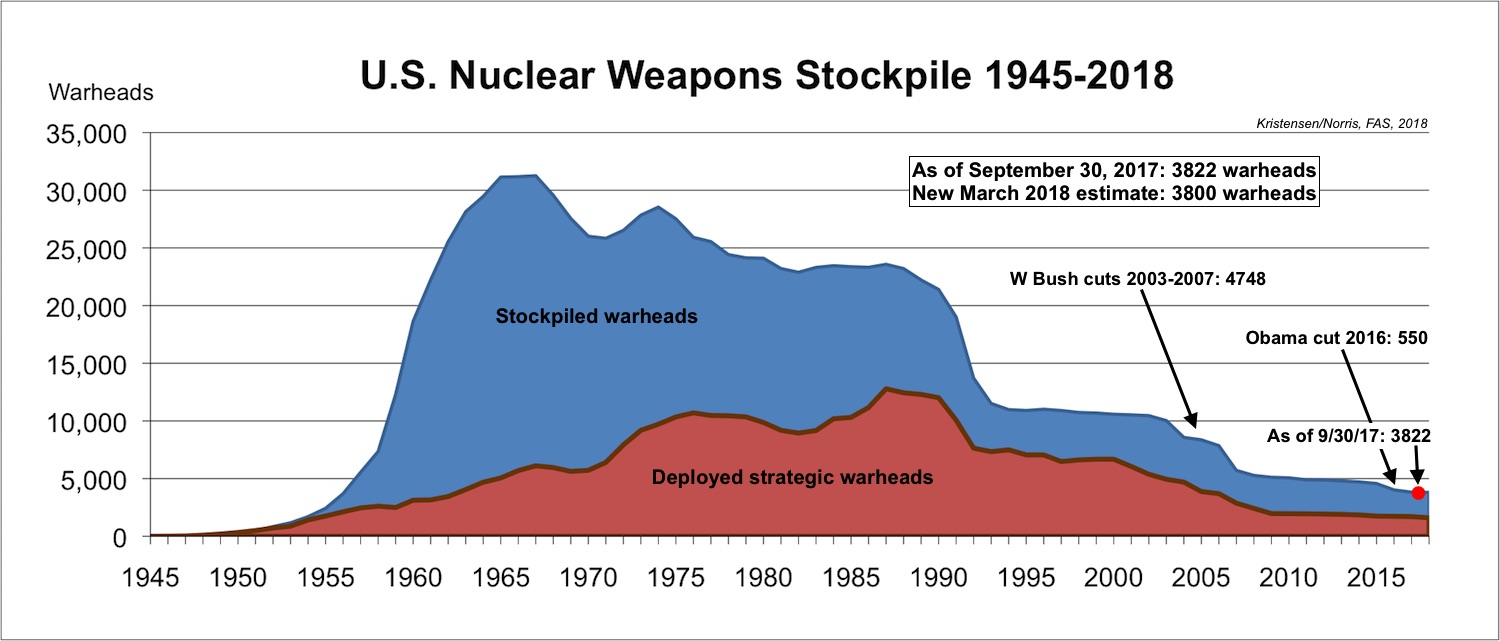Despite Rhetoric, US Stockpile Continues to Decline

Click on image to view full size. Full document here.
By Hans M. Kristensen
The US nuclear weapons stockpile dropped to 3,822 warheads by September 2017 – down nearly 200 warheads from the last year of the Obama administration, according to new information released by the Department of Defense in response to a request from the Federation of American Scientists (see here for full document).
Since September 2017, the number has likely declined a little further to about 3,800 warheads as of March 2018. This is the lowest number of stockpiled warheads since 1957 (see graph), although the nuclear weapons and the conventional capabilities that make up today’s arsenal are vastly more capable than back then.
The new data also shows that the United States dismantled 354 warheads during the period October 2016 to September 2017 – the highest number of warheads dismantled in a single year since 2009. Since 1994, the United States has dismantled nearly 11,000 nuclear warheads.
The continued reductions are not the result of new arms control agreements or a change in defense planning, but reflects a longer trend of the Pentagon working to reduce excess numbers of warheads while upgrading the remaining weapons. This trend is as old as the Post Cold war era.
The majority of the warheads retired during the Trump administration’s first year probably included W76-0 warheads no longer needed as feedstock for the Navy’s W76-1 life-extension program.
The reduction has happened despite tensions with Russia, bombastic nuclear statements by President Donald Trump, and Nuclear Posture Review assertions about return of Great Power competition and need for new nuclear weapons.
The apparent disconnect between rhetoric and the stockpile trend illustrates that nuclear deterrence and national security are less about the size of the arsenal than what it, and the overall defense posture, can do and how it is postured.
Although defense hawks home and abroad will likely seize upon the reduction and argue that it undermines deterrence and reassurance, the reality is that it does not; the remaining arsenal is more than sufficient to meet the requirements for national security and international obligations. On the contrary, it is a reminder that there still is considerable excess capacity in the current nuclear arsenal beyond what is needed.
President Trump recently said he expected to meet Russian President Vladimir Putin “in the not-too-distant future to discuss the arms race,” which Trump added “is getting out of control…” He is right. In such discussions he should urge Russia to follow the U.S. example and also disclose the size of its nuclear warhead stockpile, agree to extend the New START treaty for five years, work out a roadmap to resolve INF Treaty compliance issues, and develop new agreements to regulate nuclear and advanced conventional forces.
There is much work to be done.
Additional information:
Declassified stockpile numbers.
Recent FAS Nuclear Notebook on US nuclear forces (written before the new stockpile information became available).
For an overview of all nuclear-armed states, see our Status of World Nuclear Forces.
This publication was made possible by a grant from the Carnegie Corporation of New York, the John D. and Catherine T. MacArthur Foundation, the New Land Foundation, and the Ploughshares Fund. The statements made and views expressed are solely the responsibility of the author.
Satellite imagery has long served as a tool for observing on-the-ground activity worldwide, and offers especially valuable insights into the operation, development, and physical features related to nuclear technology.
This report outlines a framework relying on “Cooperative Technical Means” for effective arms control verification based on remote sensing, avoiding on-site inspections but maintaining a level of transparency that allows for immediate detection of changes in nuclear posture or a significant build-up above agreed limits.
The grant comes from the Carnegie Corporation of New York (CCNY) to investigate, alongside The British American Security Information Council (BASIC), the associated impact on nuclear stability.
Satellite imagery of RAF Lakenheath reveals new construction of a security perimeter around ten protective aircraft shelters in the designated nuclear area, the latest measure in a series of upgrades as the base prepares for the ability to store U.S. nuclear weapons.
